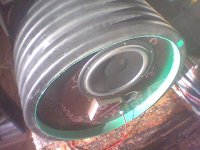hi all!
does anyone know anything about using a DYNAUDIO 30 W-100 in a subwoofer? i intend using the woofer to get the deepest possible low end for music use. this means i don't need superbly high SPL's! just deep, punchy bass...
anyone any suggestions?
thanks alot guys🙂
does anyone know anything about using a DYNAUDIO 30 W-100 in a subwoofer? i intend using the woofer to get the deepest possible low end for music use. this means i don't need superbly high SPL's! just deep, punchy bass...
anyone any suggestions?
thanks alot guys🙂
The 30w100 has quite high values for Qes and Vas, it seems to work best in a large sealed box. 200 liter sealed for Qtc of 0,93. Or perhaps, with multiple woofers, in dipole configuration. I think the bass-reflex is not recommended for this driver, because of that high Q-factor...?
--offtopic--
The XL version of 30W100 has lower Qes (and Qts) value, so it works in smaller enclosures. I have the 30W100XL-8 currently in a 83 liter aperiodically vented testing-enclosure and it performs nicely. It goes to at least ~24Hz in my room.
It is, of course, quite insensitive subwoofer because of sealed enclosure. But like you, I don't need high SPL levels and i'm starting to kinda like the "sealed" sound... 😉
--offtopic--
The XL version of 30W100 has lower Qes (and Qts) value, so it works in smaller enclosures. I have the 30W100XL-8 currently in a 83 liter aperiodically vented testing-enclosure and it performs nicely. It goes to at least ~24Hz in my room.
It is, of course, quite insensitive subwoofer because of sealed enclosure. But like you, I don't need high SPL levels and i'm starting to kinda like the "sealed" sound... 😉
I've used them in transmission lines and sealed isobarics. It's a good driver with a surprisingly weak magnet considering its price and reputation.
pic
Here is a pic of my 30W100XL testing enclosure. Sure it looks like s**t, but anyway it sounds surprisingly good
The final version propably has end caps made of 25mm MDF (currently 20mm veneer). But I'm still wondering how should I finish that surface to make it look acceptable for living-room.
Also, placement of amp+xo+stuff in a sub-enclosure confuses me a bit...maybe I should put one dividing wall (25mm MDF) in the tube, to separate the electronics from the woofer's air flow?
Currently, building the sub amp and cross-over keeps me busy for some time. I hope I'll get it working well. 🙂
Here is a pic of my 30W100XL testing enclosure. Sure it looks like s**t, but anyway it sounds surprisingly good

The final version propably has end caps made of 25mm MDF (currently 20mm veneer). But I'm still wondering how should I finish that surface to make it look acceptable for living-room.
Also, placement of amp+xo+stuff in a sub-enclosure confuses me a bit...maybe I should put one dividing wall (25mm MDF) in the tube, to separate the electronics from the woofer's air flow?
Currently, building the sub amp and cross-over keeps me busy for some time. I hope I'll get it working well. 🙂
Attachments
keyser said:hi all!
does anyone know anything about using a DYNAUDIO 30 W-100 in a subwoofer? i intend using the woofer to get the deepest possible low end for music use. this means i don't need superbly high SPL's! just deep, punchy bass...
anyone any suggestions?
thanks alot guys🙂
I remember ( was it speakerbuilder magazine ) building a coffetable subwoofer for 2 x Dynaudio 30 W-100 or was it 54's.
It measured approx 1,5 m x 60-80 cm and was as tall as a average coffetable...
Quite big...🙂
The article must be at least 10 years old. I don't have the article.
that's guite big!
i used a program to calculate a box for the unit, and i too came to a coffeetable kind of box, with no less than 960 liters!
big is no problem, but this is just a bit too much.
perhaps a transmissionline would be a good idea...
i used a program to calculate a box for the unit, and i too came to a coffeetable kind of box, with no less than 960 liters!
big is no problem, but this is just a bit too much.
perhaps a transmissionline would be a good idea...
- Status
- Not open for further replies.
